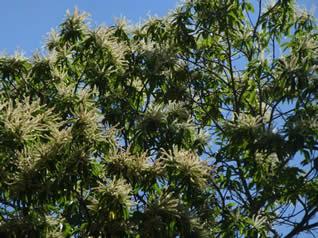Latin name: Castanea sativa
by Vancouver Island Master Gardeners Association
Sweet or Spanish chestnut trees produce the edible chestnuts known from Christmas carols. Trees grow to be huge: Sweet Chestnut trees grow up to 100 ft (30 m) in height. The edible seeds (the chestnuts) emerge from fruit capsules which externally look like a hedgehog curled into a protective ball. Inside the sharp casing which deter predators are 2 -3, sometimes up to 7 nuts which ripen in October. These are an attractive shiny brown colour, similar to the inedible horse chestnuts. The tree is monoecious, i.e. both male and female flowers are found on the same tree, and they are pollinated by bees.
In milder parts of Europe, forests of edible chestnuts are found. This attracts wildlife that feast on the nuts. Also, prior to the introduction of the potato into Europe, forest dwelling communities where wheat was scarce used chestnuts as a main source of carbohydrates. The nuts are still harvested for cooking and roasting in many parts of the world and are valuable nutritionally especially in the B vitamins and Vitamin C.
The Castanea sativa tree at Milner Gardens is located at the top of the Orchard between the bee hives and the Gardener's Cottage.




Photos courtesy of: Dorothee Kieser and Kay Howard.
Attribute | Description |
|---|---|
Form: | Large, long-lived deciduous tree. |
Foliage type: | The oblong-lanceolate, boldly toothed leaves are glossy and hard, approximately 8” (20 cm) long. |
Height/Width: | Up to 100 ft (30m) in height, 50 ft (15 m) in diameter. |
Hardiness Zone: | Zone 5b. |
Exposure: | Tolerates shade. |
Flower colour: | Yellowish-white catkins with male flowers on top, female flowers closer to branch. |
Leaf colour: | Dark green. |
Flower time: | June/July; Fruit ripening: October. |
Preferred soil and Watering: | Requires adequate moisture, but soil needs to be well drained. Trees are lime intolerant. Trees are able to grow in nutritionally poor soil. They grow in sandy, loamy or even in clay soil. |
Other: | Castanea sativa belongs into the family Fagaceae (Beech family.) |

